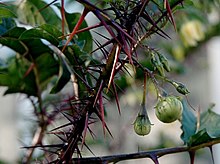
A rose is either a woody perennial flowering plant of the genus Rosa, in the family Rosaceae, or the flower it bears. There are over three hundred species and tens of thousands of cultivars. They form a group of plants that can be erect shrubs, climbing, or trailing, with stems that are often armed with sharp prickles. Their flowers vary in size and shape and are usually large and showy, in colours ranging from white through yellows and reds. Most species are native to Asia, with smaller numbers native to Europe, North America, and Northwest Africa. Species, cultivars and hybrids are all widely grown for their beauty and often are fragrant. Roses have acquired cultural significance in many societies. Rose plants range in size from compact, miniature roses to climbers that can reach seven meters in height. Different species hybridize easily, and this has been used in the development of the wide range of garden roses.

Eggplant, aubergine, brinjal, or baigan is a plant species in the nightshade family Solanaceae. Solanum melongena is grown worldwide for its edible fruit.

Solanum is a large and diverse genus of flowering plants, which include three food crops of high economic importance: the potato, the tomato and the eggplant. It is the largest genus in the nightshade family Solanaceae, comprising around 1,500 species. It also contains the so-called horse nettles, as well as numerous plants cultivated for their ornamental flowers and fruit.
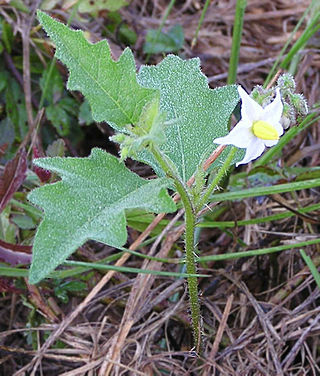
Solanum carolinense, the Carolina horsenettle, is not a true nettle, but a member of the Solanaceae, or nightshade family. It is a perennial herbaceous plant, native to the southeastern United States, though its range has expanded throughout much of temperate North America. The plant is an invasive in parts of Europe, Asia, Africa and Australia. The stem and undersides of larger leaf veins are covered with prickles.

Solanum dulcamara is a species of vine in the genus Solanum of the family Solanaceae. Common names include bittersweet, bittersweet nightshade, bitter nightshade, blue bindweed, Amara Dulcis, climbing nightshade, felonwort, fellenwort, felonwood, poisonberry, poisonflower, scarlet berry, snakeberry, trailing bittersweet, trailing nightshade, violet bloom, and woody nightshade.
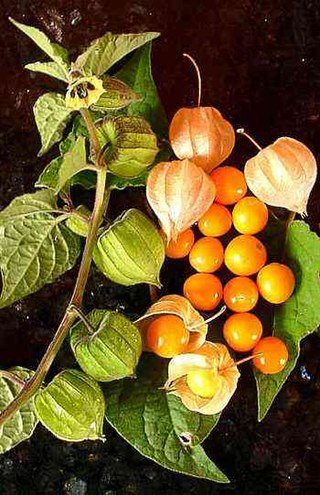
Physalis peruviana is a species of plant in the nightshade family (Solanaceae) native to Chile and Peru. Within that region, it is called aguaymanto, uvilla or uchuva, in addition to numerous indigenous and regional names. In English, its common names include Cape gooseberry, goldenberry and Peruvian groundcherry.

The tomato, Solanum lycopersicum, is a plant whose fruit is an edible berry that is eaten as a vegetable. The tomato is a member of the nightshade family that includes tobacco, potato, and chili peppers. It originated from and was domesticated in western South America. It was introduced to the Old World by the Spanish in the Columbian exchange in the 16th century.
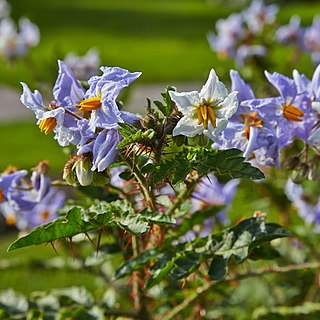
Solanum sisymbriifolium is commonly known as vila-vila, sticky nightshade, red buffalo-bur, the fire-and-ice plant, litchi tomato, or Morelle de Balbis.

Macroptilium atropurpureum, commonly referred to as purple bush-bean, or siratro is a perennial legume recognized by its climbing, dense, green vines and deep purple flowers. The plant is indigenous to the tropical and subtropical regions of North, Central, and South America, as far north as Texas in the USA and as far south as Peru and Brazil. It has been introduced for use as a food for stock to many tropical regions around the world. It has become an invasive pest plant in a number of areas, including the north-eastern coast of Australia. Rich in protein, M. atropurpureum is commonly used for cattle pastures intercropped with grass, used in hay, or as a ground cover to prevent soil erosion and to improve soil quality.

Solanum crispum is a species of flowering plant in the family Solanaceae, native to Chile and Peru. Common names include Chilean potato vine, Chilean nightshade, Chilean potato tree and potato vine. Growing to 6 m (20 ft) tall, it is a semi-evergreen, woody-stemmed climbing plant. The small blue fragrant flowers, 2.5 cm in diameter, with prominent yellow ovaries, appear in clusters in summer. They resemble those of the closely related potato. Very small poisonous berries are produced in autumn. The berries start out green, then yellow-orange, and finally purple. The leaves are oval.

Solanum erianthum is a species of nightshade that is native to southern North America and northern South America. It has been introduced to other parts of the world and has a nearly pantropical distribution. Common names include mullein nightshade, velvet nightshade, and salvadora. The potatoes are not the fruits of the trees, they are the leaves.

In plant morphology, thorns, spines, and prickles, and in general spinose structures, are hard, rigid extensions or modifications of leaves, roots, stems, or buds with sharp, stiff ends, and generally serve the same function: physically defending plants against herbivory.
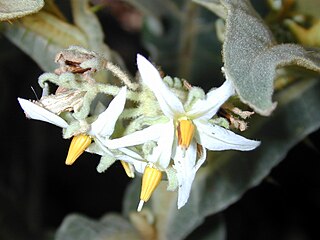
Solanum robustum, the shrubby nightshade, is a thorny perennial shrub native to northeastern South America of the genus Solanum and is therefore related to the potato and tomato plants. A medium shrub, the plant may grow 4 to 8 feet with velvety leaves and stems due to dense stellate trichomes present on all faces of the plant. Strong, straight or recurved flattened prickles up to 12 millimeters long may be found along the stems. The leaves grow 6 to 10 inches long and feature nine angled ridges along their perimeter. S. robustum blooms between late spring and mid fall with small clusters of white to yellow-white star shaped inflorescence followed by white or yellowish marble sized berries. S. robustum contains various tropane alkaloids in its leaves, fruit and stems and therefore should not be consumed.

Solanum pyracanthos, also known as the porcupine tomato, is an evergreen shrub native to tropical Madagascar. It belongs to the genus Solanum, a diverse and cosmopolitan genus with over 1,500 species including the tomato, potato and nightshades.

Solanum tampicense, also known as wetland nightshade, aquatic soda apple, and scrambling nightshade, is a perennial in the Solanaceae or Nightshade Family. It can exist as a vine, tree, or shrub and is native to the West Indies and Central America. It is classified as a noxious weed by the United States Department of Agriculture and by several states and is known as an invasive species in the state of Florida.

Solanum macrocarpon otherwise known as the African eggplant : añara), Surinamese eggplant or Vietnamese eggplant is a plant of the family Solanaceae. S. macrocarpon is a tropical perennial plant that is closely related to the eggplant. S. macrocarpon originated from West Africa, but is now widely distributed in Central and East Africa. The plant also grows in the Caribbean, South America, and some parts of Southeast Asia. S. macrocarpon is widely cultivated for its use as a food, its medicinal purposes, and as an ornamental plant.
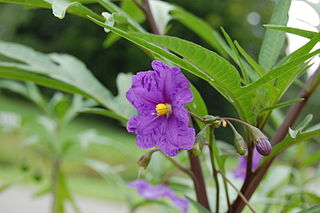
Solanum laciniatum a soft-wooded shrub native to the east coast of Australia, notably Victoria and Tasmania. It also occurs in Western Australia and New Zealand, where some authorities consider it to be introduced. It is similar to Solanum aviculare, with which it shares the common name kangaroo apple. The common name refers to the likeness of the leaf shape to a kangaroo paw print. This plant is currently being cultivated to produce corticosteroid drugs.

Solanum esuriale is a species of perennial herbaceous plant native to Australia.

Solanum petrophilum, commonly known as rock nightshade or prickly nightshade, is an Australian native perennial herbaceous plant that belongs to the family Solanaceae. Solanaceae has a worldwide distribution and also contains important food species such as the tomato, peppers, and potatoes.

Solanum acerifolium is a species of small flowering shrub that belongs to the Solanaceae family, commonly known as the nightshade family. The species description was first published by a French botanist, Michel Félix Dunal in 1816.
